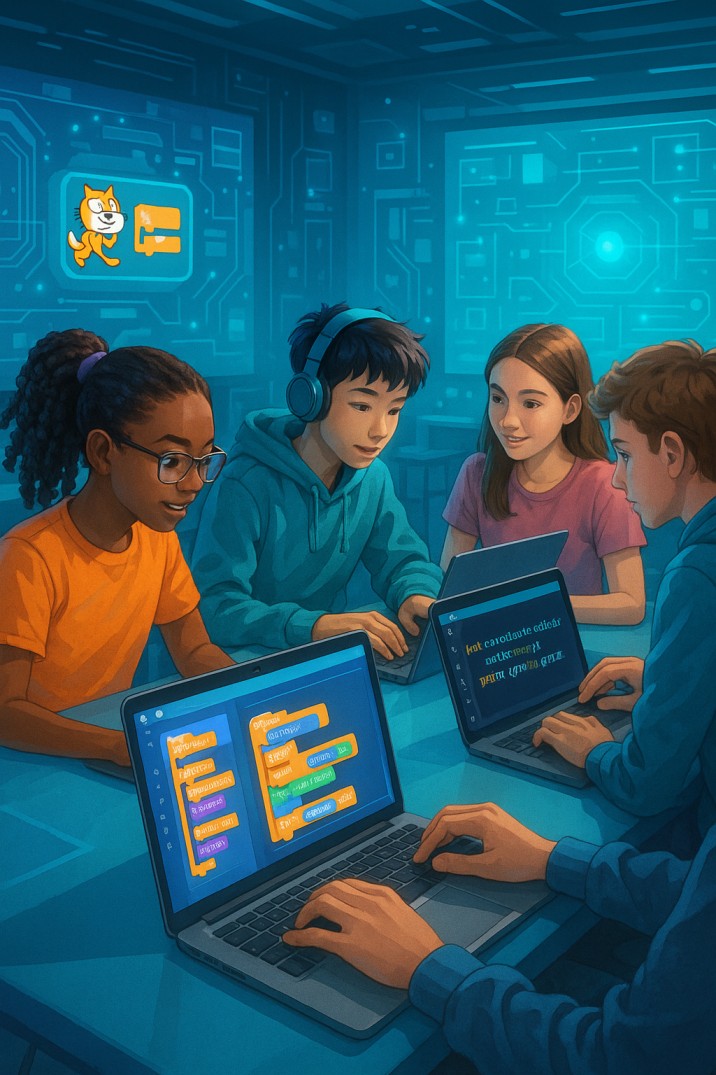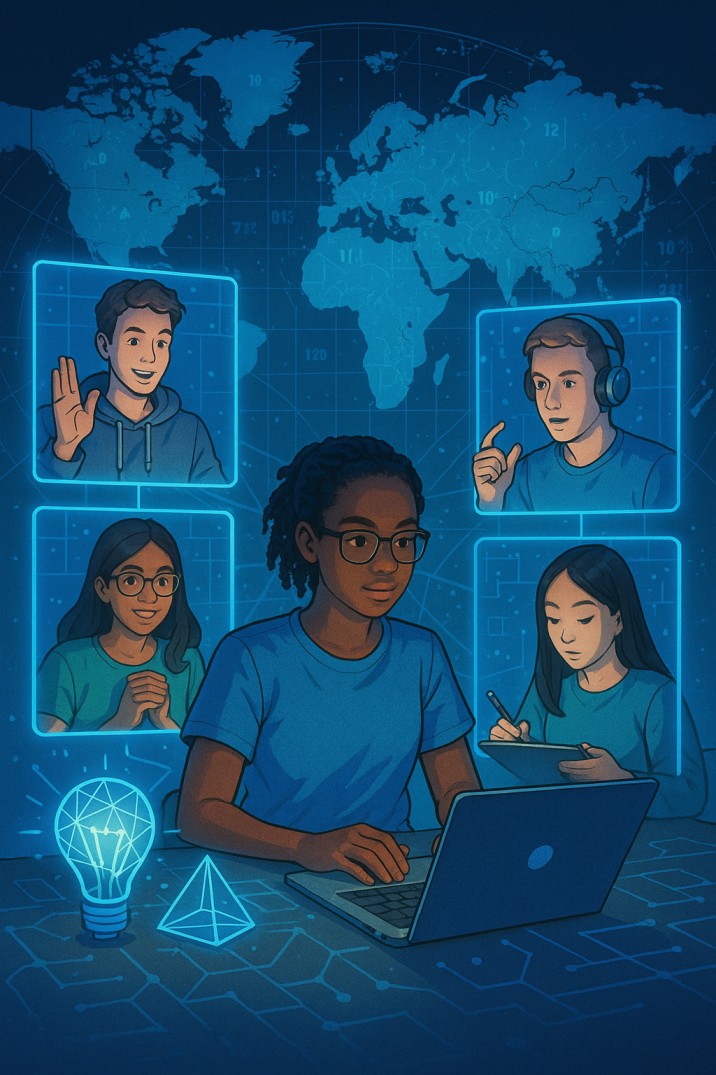
A while ago, STEM courses amounted to sitting in a lecture hall, copying equations off the board, and hoping lab day was more than pouring water into salt. STEM education today is no longer about rote learning or boring lectures. STEM education innovation out of the box, tech-driven, and a fun change, is seen.
If you’re a student now, you’re in for a different experience than students a decade ago.
Here’s what you can expect today in a classroom with STEM education innovation in today’s times:
1.You’ll Build More, Memorize Less
Forget merely memorizing definitions. Now, you may be required to design your functioning model, such as a line-following robot or a functioning mini water filter. These are not side projects—these are what you do in class. You learn through practice.
And, believe it or not, it’s much more fun than studying for an MCQ test.
2.Coding Is No Longer Optional
You don’t have to become a software engineer, but being able to code—even at a foundational level—is becoming an essential skill in STEM learning. From making a game in Scratch to solving problems with Python, coding is being introduced to build logic, structure, and problem-solving skills.
It’s not computer-based; it’s a way of thinking.

3.Real-World Problems Are in the Syllabus
STEM is increasingly tied to what is going on in the world. You may be challenged to identify environmentally friendly substitutes for plastic, create inexpensive medical equipment, or construct models to save energy.
The concept is to show students how to solve issues that count. It’s a sense of purpose, and it demonstrates how STEM can benefit individuals.
4.AI Tools Are Your Personal Study Buddies
With AI stepping into classrooms, learning is becoming a lot more personalized. Platforms that track how you learn, what you struggle with, and offer practice exist that are tailored to you.
5.Collaborations
You get to learn how to work together, acclimatize to new viewpoints, and get exposure that textbooks just can’t provide through online hackathons, STEM competitions, and virtual science fairs also enabling students to work together across different time zones.

6.Tech Is Reaching Rural and Underserved Classrooms
Even though the digital divide does exist, it’s getting smaller. Offline learning kits, low-data virtual labs, and open coding tools, allows more students from low-income backgrounds to gain access to quality STEM education. Innovation is no longer solely for city schools—and that’s a huge victory.
7.Ethical Thinking and Sustainability Are Core Lessons
Not only are today’s STEM students learning how to construct, but they’re also learning whether we should construct. There is greater emphasis on climate change, ethical artificial intelligence, and green solutions.
Final Thoughts
When you think of innovation and technology in science, it is seen in a manner that’s inclusive, innovative, and inspiring and regardless of whether you’re constructing a drone, programming a basic app, or simply learning about how a rocket operates—curiosity is the most important thing that is contributed. The future is not just learned anymore. With all the advancements, technology in science is being constructed—by you and your peers.
References
- National Science Teaching Association. Project-Based Learning in STEM Classrooms [Internet]. 2023 [cited 2025 Aug 7].
- Inclusive STEM Education for All [Internet]. 2024 [cited 2025 Aug 7].
- Khan Academy. Personalised Learning through AI [Internet]. 2024 [cited 2025 Aug 7].
- Virtual Laboratories for Modern Science Teaching [Internet]. 2025 [cited 2025 Aug 7].
- Harvard University. Integrating Ethics and Sustainability in STEM Education [Internet]. 2023 [cited 2025 Aug 7].
- Scratch Foundation. Learning to Code: Beyond Syntax [Internet]. 2023 [cited 2025 Aug 7].
- World Economic Forum. Global Collaboration in Education [Internet]. 2025 [cited 2025 Aug 7].
FAQs on STEM Education Innovation
1. What does STEM education innovation mean?
STEM education innovation refers to the new ways of teaching Science, Technology, Engineering, and Mathematics that go beyond traditional lectures and rote learning. It focuses on hands-on experiments, coding, real-world projects, and integrating technology in science classrooms. Instead of just memorizing, students actively build, create, and solve problems.
2. Why is STEM education innovation important for students today?
It matters because today’s world runs on technology and problem-solving. By experiencing STEM education innovation, students learn practical skills like coding, robotics, sustainability, and teamwork. These prepare them for jobs that didn’t even exist a decade ago. More importantly, it nurtures curiosity, creativity, and logical thinking.
3. How is technology in science changing classrooms?
Technology in science classrooms is making learning interactive. Smart boards, AI-powered platforms, virtual labs, and simulation tools allow students to test ideas safely and creatively. For example, instead of only reading about a rocket launch, students can simulate one digitally and understand the mechanics in real time.
4. What kind of hands-on projects are part of STEM education innovation?
Students now build line-following robots, design eco-friendly packaging, create apps with coding, or even develop affordable medical prototypes. These aren’t side projects—they are core classwork. The idea is to build more and memorize less, making STEM more exciting and practical.
5. Is coding really necessary for everyone in STEM?
Yes, but only at a foundational level. STEM education innovation ensures even non-programmers get exposure to logic-based coding. Tools like Scratch, Python, and simple robotics kits teach how to think structurally and solve problems. It’s less about becoming a software engineer and more about developing problem-solving habits.
6. How do real-world problems connect with STEM classes?
Modern STEM classes often ask students to solve global issues. For instance, they may research alternatives to plastic, create models that save energy, or design water purifiers for rural areas. This gives a sense of purpose—students see how their classroom work can improve lives.
7. What role does AI play in STEM education innovation?
AI is becoming like a personal tutor. Adaptive learning platforms track how a student learns, highlight weak areas, and offer practice questions accordingly. Instead of a one-size-fits-all system, AI customizes lessons, making science and math easier to grasp for every student.
8. How does STEM education promote collaboration?
STEM isn’t a solo journey. Students participate in online hackathons, science fairs, and coding competitions across the globe. Collaborating virtually with students from different countries exposes them to new perspectives and teaches real teamwork—an essential skill for any career.
9. How is STEM innovation reaching rural and underserved areas?
This is one of the most exciting parts. Low-data virtual labs, offline STEM kits, and free open-source coding platforms are bridging the gap. Technology in science is no longer just for urban schools. Students in remote areas now have access to quality STEM education, which levels the playing field.
10. What ethical issues are included in STEM education innovation?
Today’s STEM students don’t just ask “Can we build it?” but also “Should we build it?”. Topics like climate change, ethical AI, and sustainable design are part of the curriculum. This builds socially responsible innovators who think about the bigger picture.
11. How does STEM education innovation prepare students for careers?
Careers in engineering, data science, AI, healthcare, renewable energy, and biotechnology all depend on skills built through STEM education. By focusing on coding, hands-on projects, and innovation, students graduate job-ready. They also gain transferable skills like critical thinking and communication, which apply to any field.
12. What are some examples of technology in science classrooms?
Examples include:
Virtual labs where experiments happen digitally.
3D printers for building models and prototypes.
Robotics kits for learning mechanics and coding.
AI dashboards that track student progress.
These tools turn classrooms into creative workshops instead of passive lecture halls.
13. Can STEM education innovation help with sustainability?
Absolutely. Many STEM projects are designed around green solutions. Students work on solar-powered gadgets, waste-reduction systems, or energy-efficient models. This way, innovation isn’t just about technology—it’s about creating a sustainable future.
14. How can students get involved in STEM education innovation outside class?
They can join STEM clubs, participate in hackathons, explore open-source coding platforms like GitHub, or take part in online science competitions. Platforms like Khan Academy, Scratch Foundation, and Virtual Labs provide free tools to continue learning beyond school.
15. What is the future of STEM education innovation?
The future is even more immersive and global. Expect more AI-driven learning assistants, virtual reality classrooms, global team projects, and an even stronger link between STEM education and solving real-world issues like climate change. Students won’t just study technology in science—they’ll help shape it
Penned by Ridham Chadha
Edited by Ragi Gilani, Research Analyst
For any feedback mail us at [email protected]
Transform Your Brand's Engagement with India's Youth
Drive massive brand engagement with 10 million+ college students across 3,000+ premier institutions, both online and offline. EvePaper is India’s leading youth marketing consultancy, connecting brands with the next generation of consumers through innovative, engagement-driven campaigns. Know More.
Mail us at [email protected]